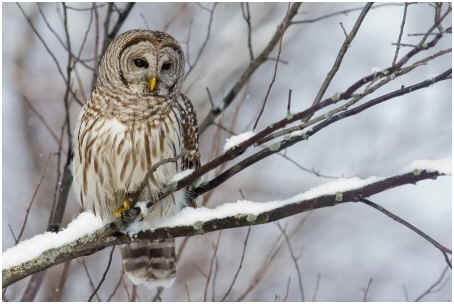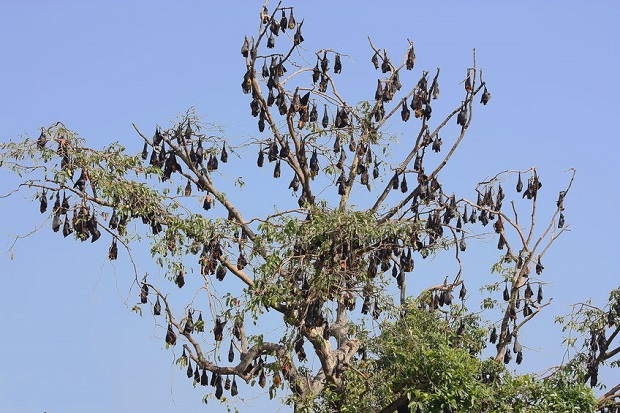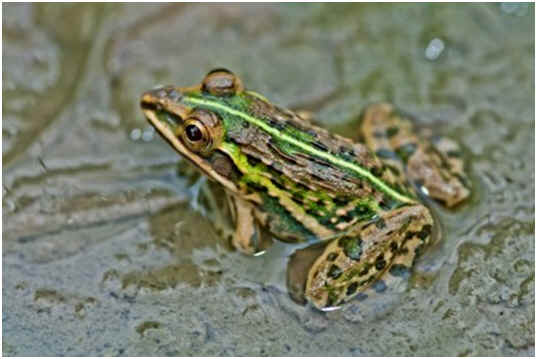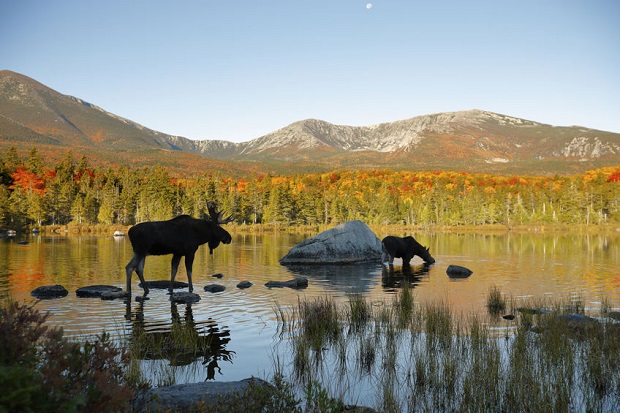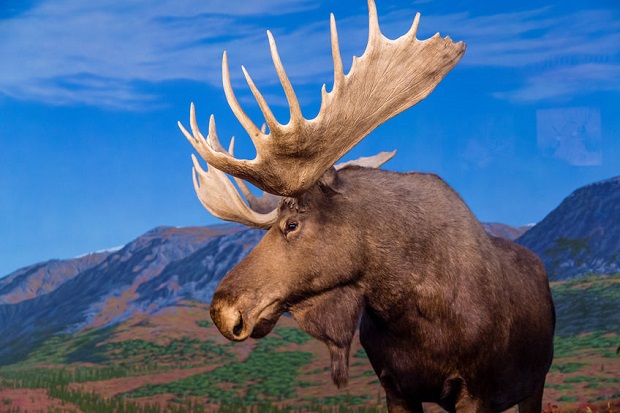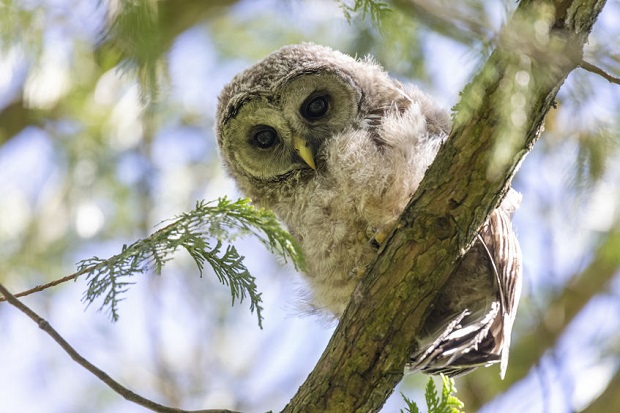
Discover answers to the most popular questions about barred owls, including classification, identification, habitat and range, hunting and diet, behavior, and conservation status.
Classification
How Are Barred Owls Classified?
Phylum: Chordata
Subphylum: Vertebrata
Class: Aves
Order: Strigiformes
Family: Strigidae
Genus: Strix
Species: S. varia
Identification
What Does a Barred Owl Look Like?
The Barred Owl’s underparts, chest, and head are gray with dark brown barring. Its dark brown back is spotted with white. Its mottled grayish-brown feathering is the perfect camouflage for its environment among the trees. Its facial disk is outlined with rings of color working inward toward the eyes, which are dark.
How Big Is a Barred Owl?
At 16.9 to 19.7 inches tall, the Barred Owl is only slightly smaller than the Great Horned Owl. It has a wingspan of nearly 3-4 feet and weighs 16.6-37 ounces. [Cornell] Like most owl species, the female Barred Owl is larger than the male.
What Do Barred Owls Sound Like?
The Barred Owl is often difficult to identify by its hoot because they make such a myriad of different sounds that can easily be confused for having several different bird species in the area. The distinctive hoot arrangement is pretty and very owl-like, but some of its other calls are fascinating such as the pair caterwauling, which sounds like something you would hear from an exotic creature in the rainforest. The Cornell Lab of Ornithology has wonderful recorded examples of various Barred Owl calls.
Habitat and Range
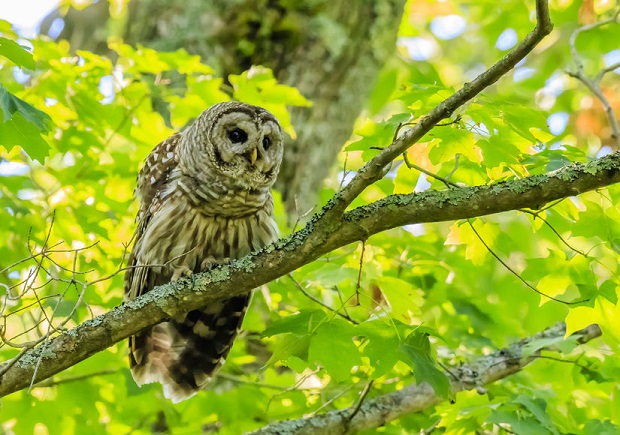
Are Barred Owls Only Found in the United States?
The Barred Owl is widely distributed throughout North America, including the United States, Canada, and Mexico. In Canada, it can be found in British Columbia, Canada, extending eastward through Alberta, Saskatchewan, Manitoba, Ontario, Quebec, New Brunswick, Prince Edward Island, and Nova Scotia.
It is widely distributed throughout the eastern United States, as far south as Texas, the Gulf Coast, and southern Florida. It has recently expanded westward and can be found in southern Alaska and the Pacific Northwest.
It extends further south into the Plateau of Mexico from Durango S to Guerrero and Oaxaca.
[Sibley]
Where Do Barred Owls Nest?
Barred Owls prefer to find cover in densely vegetated forests. They make a home of any secure tree hollow that will provide them with adequate protection. Trees of choice are tall and mature with dense foliage with hollows more than 25 feet from the ground. [Allen]
Less often, they may occupy large, abandoned nests of crows, hawks, or squirrels. The fact that they are often found nesting in wetlands has previously drawn the conclusion that they prefer to live next to a water source, but current research is indicating that this habitat selection may be due in part to the vegetation selection of these areas more than a desire to live close to a water source. [Allen]
Hunting and Diet
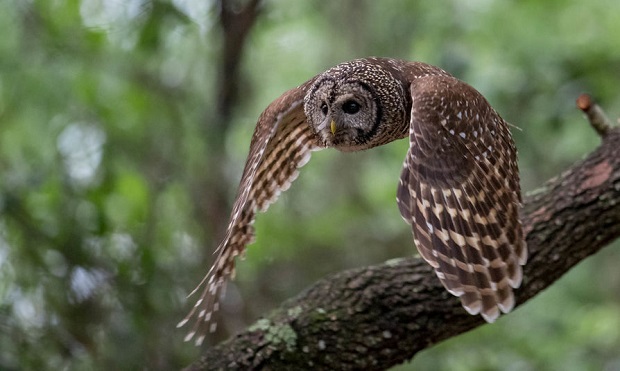
What Do Barred Owls Eat?
Barred Owls will feed on small mammals such as mice, squirrels, juvenile rabbits, chipmunks, and bats. They will feed on fish, amphibians, reptiles, and birds to a lesser extent. Like all owls, Barred Owls are birds of prey, making a meal of what is available to them in the ecosystem, so the prey they feed on primarily is what is in the greatest abundance for the area. For example, in Montana, researchers recorded that meadow and montane voles account for 96.3% of their diet, while in Louisiana, crayfish make up a larger portion of their diet. [Allen]
Owls do not digest food in the same manner that we do. They swallow their food whole, and the parts that cannot be digested, the bones, teeth, fur, etc., are compacted into pellets and coughed up.
How Do Barred Owls Catch Their Prey?
The Barred Owl is a still hunter perching in a favorite spot until it locates prey. They will then swoop down from the perch and grab the prey with their sharp talons.
Do Barred Owls Have Predators?
The Barred Owl has few predators except for the Great Horned Owl. They do need to guard their nest vigilantly against predators such as other weasels and raccoons as well as other owls and hawks that will feed on their eggs or hatchlings. [Cornell]
Behavior
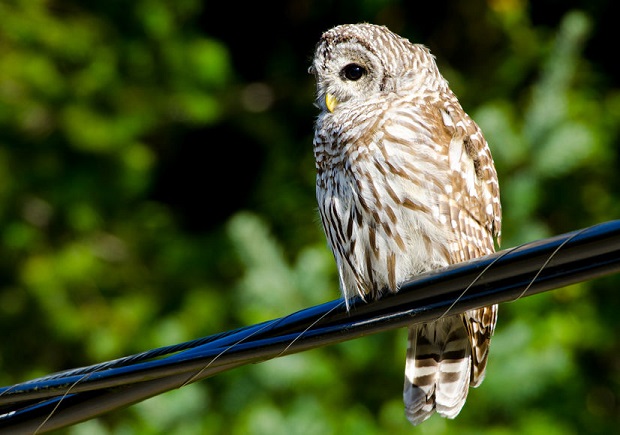
Are Barred Owls Nocturnal?
Barred Owls are primarily nocturnal, generally roosting during daylight hours. Though they cannot see in the total absence of light, they have excellent low light vision and incredible hearing that allows them to locate small prey at incredible distances.
Do Barred Owls Migrate?
Barred owls are non-migratory and vehemently territorial, for a Barred Owl can range from 86.1to 369 hectares, ranging from about one-third to one-and-one-half square miles. [Allen]
They are initially a solitary species until they mate. They will remain with their mates in one area for their entire lives. Some movement may occur if the environment ceases to provide adequate prey or they are threatened.
Conservation Status
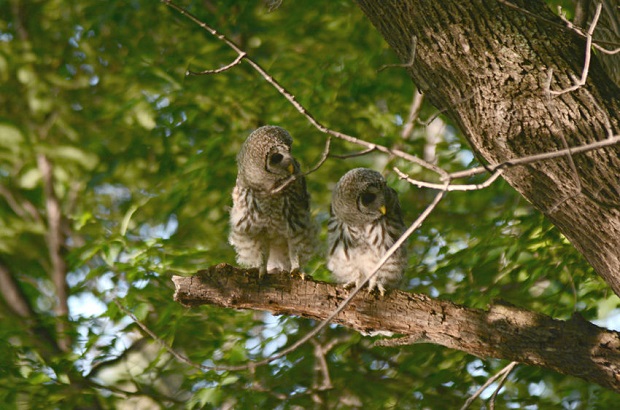
Are Barred Owls Endangered?
As of December 2013, Barred Owls in the United States are currently not protected by the Endangered Species Act of 1973 (ESA). The US Fish and Wildlife Service regulates the ESA with cooperation from the National Marines Fisheries Service. [USFWS]
Interestingly, they are a threat to the Northern Spotted Owl, listed as threatened in the United States. Due partly to the recent westward expansion of the more aggressive and larger Barred Owl, the White Spotted Owl is being pushed out of its habitat and decreasing in numbers.
When Spotted Owls and Barred Owls share the same environment, the latter are generally more aggressive and out-compete the former, leading to decreased populations of the native owls.
Resources
- Cornell University Lab of Ornithology – “Great Barred Owl”
- Jackson, Laura Spess, Carol A. Thompson, and James J. Dinsmore. The Iowa Breeding Bird Atlas.
Iowa City: University of Iowa Press, 1996. Print. - Allen, Arthur W. US Fish and Wildlife Service – “Habit Suitability Index Models: Barred Owl”
- Sibley, Charles Gald, and Burt L. Monroe. Distribution and Taxonomy of Birds of the World. New Haven: Yale University Press, 1990. Print.
- US National Park Service – “Night Calling Bird Survey 2002-2004”
- National Audubon Society – “Audubon’s WatchList 2007 in taxonomic order by geographic region”
- US Fish and Wildlife Service – “Listing a Species as Threatened or Endangered”
